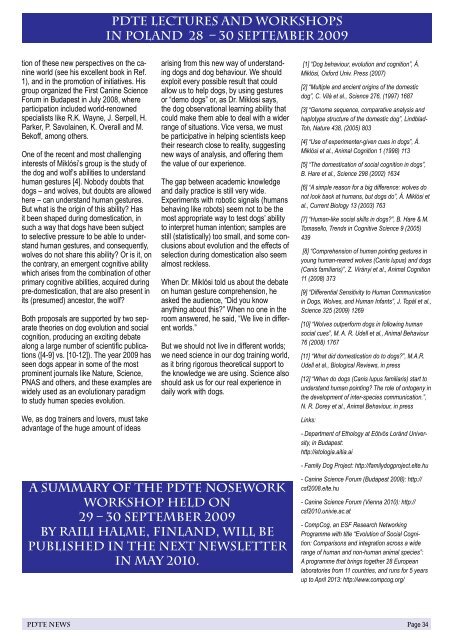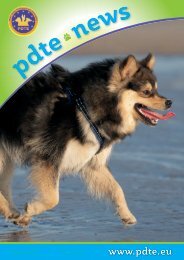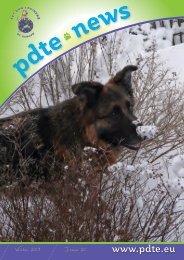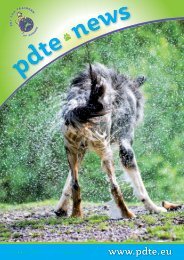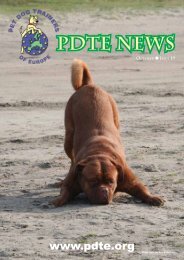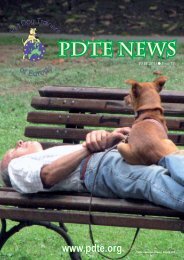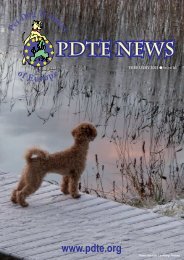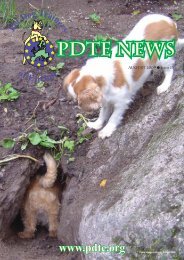PDTE 2010 January Newsletter
Create successful ePaper yourself
Turn your PDF publications into a flip-book with our unique Google optimized e-Paper software.
tion of these new perspectives on the canine<br />
world (see his excellent book in Ref.<br />
1), and in the promotion of initiatives. His<br />
group organized the First Canine Science<br />
Forum in Budapest in July 2008, where<br />
participation included world-renowned<br />
specialists like R.K. Wayne, J. Serpell, H.<br />
Parker, P. Savolainen, K. Overall and M.<br />
Bekoff, among others.<br />
One of the recent and most challenging<br />
interests of Miklósi’s group is the study of<br />
the dog and wolf’s abilities to understand<br />
human gestures [4]. Nobody doubts that<br />
dogs – and wolves, but doubts are allowed<br />
here – can understand human gestures.<br />
But what is the origin of this ability? Has<br />
it been shaped during domestication, in<br />
such a way that dogs have been subject<br />
to selective pressure to be able to understand<br />
human gestures, and consequently,<br />
wolves do not share this ability? Or is it, on<br />
the contrary, an emergent cognitive ability<br />
which arises from the combination of other<br />
primary cognitive abilities, acquired during<br />
pre-domestication, that are also present in<br />
its (presumed) ancestor, the wolf?<br />
Both proposals are supported by two separate<br />
theories on dog evolution and social<br />
cognition, producing an exciting debate<br />
along a large number of scientific publications<br />
([4-9] vs. [10-12]). The year 2009 has<br />
seen dogs appear in some of the most<br />
prominent journals like Nature, Science,<br />
PNAS and others, and these examples are<br />
widely used as an evolutionary paradigm<br />
to study human species evolution.<br />
We, as dog trainers and lovers, must take<br />
advantage of the huge amount of ideas<br />
<strong>PDTE</strong> Lectures and Workshops<br />
In Poland 28 – 30 September 2009<br />
– 27 September 2008<br />
arising from this new way of understanding<br />
dogs and dog behaviour. We should<br />
exploit every possible result that could<br />
allow us to help dogs, by using gestures<br />
or “demo dogs” or, as Dr. Miklosi says,<br />
the dog observational learning ability that<br />
could make them able to deal with a wider<br />
range of situations. Vice versa, we must<br />
be participative in helping scientists keep<br />
their research close to reality, suggesting<br />
new ways of analysis, and offering them<br />
the value of our experience.<br />
The gap between academic knowledge<br />
and daily practice is still very wide.<br />
Experiments with robotic signals (humans<br />
behaving like robots) seem not to be the<br />
most appropriate way to test dogs’ ability<br />
to interpret human intention; samples are<br />
still (statistically) too small, and some conclusions<br />
about evolution and the effects of<br />
selection during domestication also seem<br />
almost reckless.<br />
When Dr. Miklósi told us about the debate<br />
on human gesture comprehension, he<br />
asked the audience, “Did you know<br />
anything about this?” When no one in the<br />
room answered, he said, “We live in different<br />
worlds.”<br />
But we should not live in different worlds;<br />
we need science in our dog training world,<br />
as it bring rigorous theoretical support to<br />
the knowledge we are using. Science also<br />
should ask us for our real experience in<br />
daily work with dogs.<br />
[1] “Dog behaviour, evolution and cognition”, Á.<br />
Miklósi, Oxford Univ. Press (2007)<br />
[2] “Multiple and ancient origins of the domestic<br />
dog”, C. Vilà et al., Science 276, (1997) 1687<br />
[3] “Genome sequence, comparative analysis and<br />
haplotype structure of the domestic dog”, Lindblad-<br />
Toh, Nature 438, (2005) 803<br />
[4] “Use of experimenter-given cues in dogs”, Á.<br />
Miklósi et al., Animal Cognition 1 (1998) 113<br />
[5] “The domestication of social cognition in dogs”,<br />
B. Hare et al., Science 298 (2002) 1634<br />
[6] “A simple reason for a big difference: wolves do<br />
not look back at humans, but dogs do”, Á. Miklósi et<br />
al., Current Biology 13 (2003) 763<br />
[7] “Human-like social skills in dogs?”, B. Hare & M.<br />
Tomasello, Trends in Cognitive Science 9 (2005)<br />
439<br />
[8] “Comprehension of human pointing gestures in<br />
young human-reared wolves (Canis lupus) and dogs<br />
(Canis familiaris)”, Z. Virányi et al., Animal Cognition<br />
11 (2008) 373<br />
[9] “Differential Sensitivity to Human Communication<br />
in Dogs, Wolves, and Human Infants”, J. Topál et al.,<br />
Science 325 (2009) 1269<br />
[10] “Wolves outperform dogs in following human<br />
social cues”, M. A. R. Udell et al., Animal Behaviour<br />
76 (2008) 1767<br />
[11] “What did domestication do to dogs?”, M.A.R.<br />
Udell et al., Biological Reviews, in press<br />
[12] “When do dogs (Canis lupus familiaris) start to<br />
understand human pointing? The role of ontogeny in<br />
the development of inter-species communication.”,<br />
N. R. Dorey et al., Animal Behaviour, in press<br />
Links:<br />
- Department of Ethology at Eötvös Loránd University,<br />
in Budapest:<br />
http://etologia.aitia.ai<br />
- Family Dog Project: http://familydogproject.elte.hu<br />
A Summary of the <strong>PDTE</strong> Nosework<br />
workshop HELD ON<br />
29 – 30 September 2009<br />
by Raili Halme, Finland, wilL be<br />
published in THE next <strong>Newsletter</strong><br />
in may <strong>2010</strong>.<br />
- Canine Science Forum (Budapest 2008): http://<br />
csf2008.elte.hu<br />
- Canine Science Forum (Vienna <strong>2010</strong>): http://<br />
csf<strong>2010</strong>.univie.ac.at<br />
- CompCog, an ESF Research Networking<br />
Programme with title “Evolution of Social Cognition:<br />
Comparisons and integration across a wide<br />
range of human and non-human animal species”:<br />
A programme that brings together 28 European<br />
laboratories from 11 countries, and runs for 5 years<br />
up to April 2013: http://www.compcog.org/<br />
<strong>PDTE</strong> NEWS Page 34


